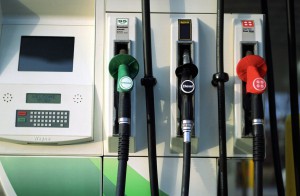
A variety of factors, including the current El Nino, could drive the price of gas to just above $1 a gallon in the months ahead.
Fuel prices have tumbled to their lowest levels since 2007 in recent days, with much of the country now paying less than $2 a gallon – but if some new forecasts are correct, motorists might soon see figures plunging to little more than $1 a gallon.
Gasoline futures fell to near seven-year lows in New York trading this week, and with traders racing to sell of their holdings in crude oil, some observers are worried that the price of a barrel could tumble to half of the $40 to $45 figure seen in recent days.
A variety of factors are at work, among them a glut of oil production, the decision by OPEC not to enact new production caps, and even the effects of El Nino, a warming of the Pacific Ocean expected to result in warmer temperatures in the U.S. – and thus, lower need for heating oil.
“Risks of a sharp leg lower remain elevated,” the influential Wall Street firm Goldman Sachs warned its clients this week.
Goldman isn’t alone in its analysis. “Gasoline’s trading range since October has been broken and in the short-term, when looking at front-month gasoline futures, the trend is now bearish,” wrote David Thompson, an analyst with the Washington-based commodities brokerage Powerhouse.
(Gas prices continue tumbling in November. For more, Click Here.)
The downside of that news has been a sharp hit to stock markets around the world, with traders worried about the impact on once-booming oil industry profits.
Barring a broader hit to the economy, however, U.S. motorists are more likely to start celebrating. As of Tuesday, the average price of a gallon of no-lead regular gasoline was down to $2.027, down more than a penny from the previous week, and about 64 cents cheaper than a year before. Michigan was listed as having the lowest average price in the U.S.
That’s in line with numbers from tracking service GasBuddy.com, which found prices in some regions dropping below $1.67 a gallon, and even in California, typically faced with some of the nation’s highest fuel prices, the figure was down below $2.70. Hawaii topped the list at just above $2.80.
Cheap fuel is also a boon for the trucking and airline industries. Airlines have been posting record or near-record profits in recent months as a result of declining fuel prices, though critics have charged that they are not passing savings onto the same consumers who saw sharply higher fees and ticket prices when fuel costs hit records in 2013 and 2014.
(Click Here to see how November truck sales set industry up for all-time record.)
Cheap gas is something of a mixed blessing for the auto industry. On the positive side, it has put more money into consumers’ pockets, money they are using to buy new vehicles in record numbers. Most analysts expect to see the year end with an all-time high of 17.4 million new cars, trucks and crossovers sold, with 2016 likely to see even bigger numbers.
And consumers are shifting away from the smaller, more fuel-efficient vehicles that dominated sales charts a couple years ago. Together, conventional sport-utility vehicles and crossover-utility models will outsell sedans when the books are closed on 2015, according to a forecast by IHS Automotive.
But there is a downside to that trend. It is making it all the harder for automakers to sell the hybrids, plug-ins and pure battery-electric vehicles they’ve been bringing to market. That will not only make it more difficult to recoup the cost of development and manufacturing, but also threaten the industry’s ability to meet new fuel economy standards.
(To see more about the finally passed Transportation Bill, Click Here.)
California regulations require large auto manufacturers to make so-called zero-emissions vehicles a certain percentage of their fleets. That is becoming more difficult and more costly, makers forced to load up on costly incentives. The alternative is being barred from selling their conventional, gas-powered products in the largest single vehicle market in the U.S.
